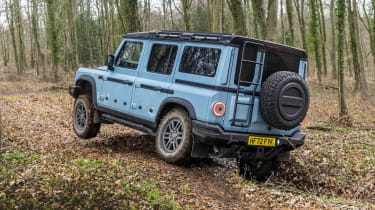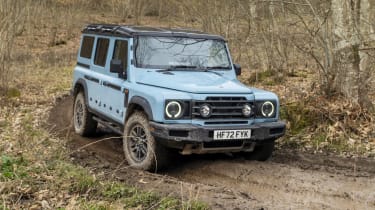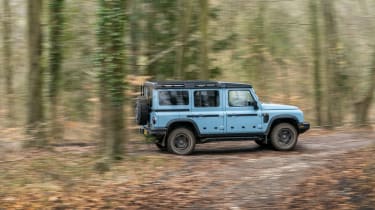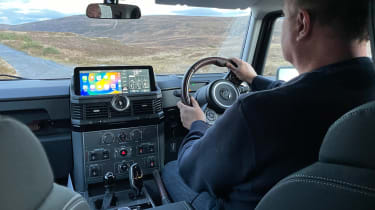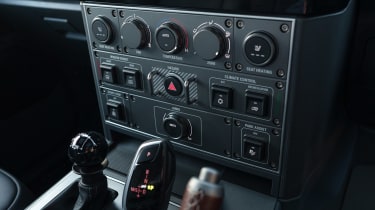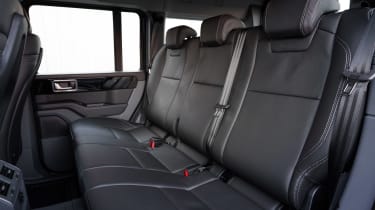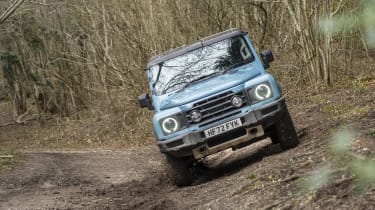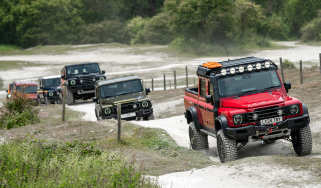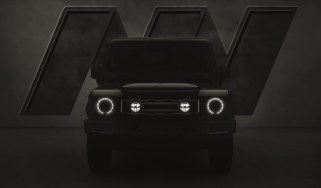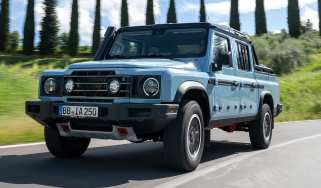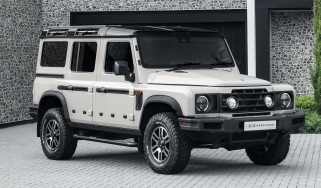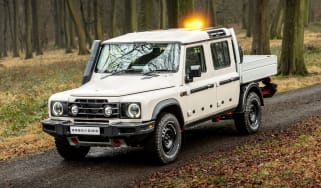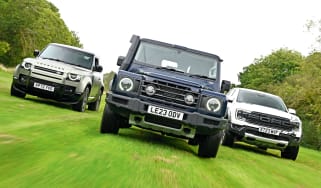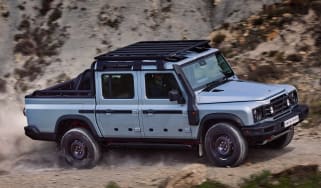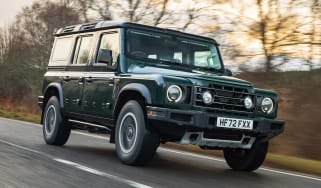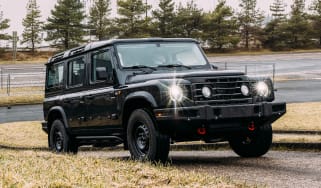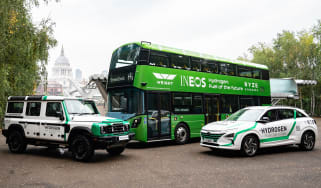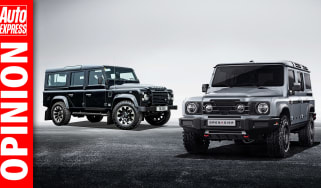Ineos Grenadier review
The Grenadier is a tough 4x4 with real off-road pedigree, but it’s far from cheap

Quick verdict
In many ways, the Ineos Grenadier is an impressive achievement for a start-up brand because the company has produced a seriously capable off-road tool with utility and toughness built in. It’s not without its quirks, however, and as you climb the range in search of more creature comforts, you get further away from the Grenadier’s core strengths, bringing more polished rivals into play.
Our choice: Ineos Grenadier 3.0 Diesel Station Wagon
|
Key specs | |
|
Fuel type |
Petrol, diesel |
|
Body style |
Six door SUV |
|
Powertrain |
3.0-litre, 6cyl, turbocharged, petrol, four-wheel drive 3.0-litre, 6cyl, turbocharged, petrol, four-wheel drive |
|
Safety |
N/A |
|
Warranty |
Five years/unlimited mileage |
Ineos Grenadier: price, specs and rivals
You might think that the modern car market is overloaded with identikit SUVs, but there’s nothing out there that’s quite like the Ineos Grenadier. Whether you’ll see that as a positive or a negative rather depends on what you want your SUV to do.
The way it looks and the intense ‘off-road utility vehicle’ focus of the design and mechanicals make it pretty clear what the Grenadier is attempting to do. Yes, we’re going to mention the D word early on. When Land Rover replaced its original Defender with the highly impressive, but significantly plusher and pricier new Defender, Ineos identified a vacancy for something basic, tough and uncompromising – like the original with a splash of the newcomer’s extra refinement. That is the Grenadier.
The car company founded by billionaire Jim Ratcliffe envisages various use cases for its vehicle in different configurations for markets around the world. Most involve getting people and equipment across mud, sand, rocks, snow or whatever treacherous terrain stands in the Grenadier’s way. But Ineos would also like a little of the fashionable kudos enjoyed by other tough off-roaders – specifically the Defender, Mercedes G-Class and Toyota Land Cruiser.
The range of bodystyles offered in the UK reflects this. First up is the Utility Wagon, which is classed as the commercial vehicle and is available with two or five seats inside. In either configuration, the Utility Wagon has been designed primarily to carry loads; in fact, there’s enough space in the two-seater version for a standard Euro pallet.
More reviews
For those wanting to use the Grenadier for carrying people, the five-seat Grenadier Station Wagon offers the most passenger space of the range. There’s also 1,255 litres of cargo space on offer, so it is suitable for family use, particularly if your loved ones are fans of off-roading.
The latest addition to the lineup is the Grenadier Quartermaster pick-up truck. This version is 305mm longer than the Wagons and features an open cargo bed at the back. There are still five seats, however the relatively low maximum payload of 760kg means that the Quartermaster doesn't qualify for the same commercial vehicle tax breaks as the Ford Ranger or Volkswagen Amarok pick-ups.
When it comes to trim levels, the standard model is the Grenadier in its most basic form with a minimalist equipment list including LED lights, 17-inch steel wheels, climate control, remote central locking, a 12.3-inch central touchscreen and a ‘water-resistant’ interior.
The Trailmaster is your extreme off-road Grenadier. It has a raised snorkel air-intake for the engine to breathe when you’re up to your headlamps in swamp and the Rough Pack, which includes front and rear differential locks in addition to the standard centre one, plus BFGoodrich All-Terrain tyres. It also includes the Smooth Pack with luxuries like a rear-view camera, heated mirrors, heated washer jets, extra charge points in the cabin and more.
The Fieldmaster is the plushest model and as close as the Grenadier gets to the comfort levels of a conventional SUV. It comes with the Smooth Pack’s items, as well as little luxuries like leather-trimmed and heated seats, carpet floor mats and 17-inch alloy wheels.
Power for the Grenadier comes from one of two 3.0-litre BMW-sourced engines, a petrol and a diesel, each using a ZF eight-speed automatic gearbox. In terms of pricing, Ineos has kept it simple, with both engines and trim levels costing the same. Pricing starts at £76,000 for either the off-road-orientated Trailmaster or ‘luxurious’ Fieldmaster, before options. In comparison, the five-door Land Rover Defender 110 starts at just under £60,500.
Engines, performance & drive
The Ineos Grenadier is an old-school 4x4, built on a tough ladder frame chassis with beam axles and coil-spring suspension. However, it isn’t the dynamic disaster you might expect for something so obviously tuned for off-road work.
There’s a lot of body roll as you pitch into corners but only up to a point. After the initial tilt, things hold reasonably steady. The ride isn’t up to the standards of a road-biased SUV, but for a dyed-in-the-wool mudplugger, it’s good. It takes the edge off bumps and doesn’t fidget around too much on rough roads, although it isn’t as refined as the Land Rover Defender. The Grenadier’s beam axles front and rear are fantastic for durability off-road, but can’t match the all-independent suspension set-up of the Defender when isolating you and your passengers from bumps.
The Defender can be optioned with adjustable air suspension, which gives it an extra 30mm of ground clearance over the Grenadier in its highest ride-height setting, along with superior approach and departure angles. The Grenadier has the better ramp or breakover angle, though, which is important for not scratching the underside of your car when driving over an obstacle.
The biggest issue is the Grenadier’s recirculating-ball hydraulic steering system because it takes a lot of getting used to. It’s light enough but at 3.85 turns from lock-to-lock, you need a huge amount of steering angle to effect a turn. Even small adjustments to keep the car tracking true on the move are tough to get right and with no self-centring effect, you have to wind off everything you’ve just put on as the road straightens out. It all feels too much like hard work, and while things improve with familiarity, everyday on-road driving is made needlessly difficult.
This is especially the case in town with a 13.5m turning circle to plan ahead for. Buyers wanting an off-roader with civilised on-road manners will prefer the Defender, which has steering that’s easier to get on with and a smaller 12.8m turning circle.
We’ve driven the Grenadier extensively off-road in Scotland and also in Sussex, and away from the tarmac is where it feels most at home. Based on our time in the car, it’s a little easier to control the throttle in the diesel model at low speeds. The petrol is sometimes a little slow to respond to initial throttle inputs but is generally well up to the job of crawling over very difficult terrain. And, of course, the Grenadier has proper low-range gearing selected via a second gear lever next to the main one, and can be ordered with the full suite of locking differentials controlled by a complex overhead panel of switches and buttons that makes you feel like an airline pilot. Rest assured that your off-roading nerve is likely to run out before the Grenadier runs out of ability.
|
Model |
Power |
0-62mph |
Top speed |
|
Grenadier 3.0 diesel Fieldmaster |
249bhp |
8.8 seconds |
99mph |
|
Grenadier 3.0 petrol Fieldmaster |
281bhp |
8.8 seconds |
99mph |
0-62mph acceleration and top speed
Go for the 282bhp 3.0-litre six-cylinder petrol, and your Ineos Grenadier will get from 0-62mph in 8.6 seconds, while the 246bhp 3.0-litre six-cylinder diesel takes 9.8 seconds. The top speed for both versions is 99mph. Ineos sensibly went to BMW to source both of the Grenadier’s straight-six engines, and we’ve spent a lot of time with both power units both on and off-road.
Of the two, we think the diesel motor makes the most sense given its superior torque of 550Nm (versus 450Nm for the petrol), which will be more useful in the rough stuff, and its fuel economy advantage. True, it’s a little more vocal and coarser than the petrol, but it’s still a smooth and refined option by the standards of the units you find in other vehicles of this type, including the 3.0-litre six-cylinder diesel found in D250 and D350 versions of the Land Rover Defender, or the 201bhp 2.8-litre four-cylinder diesel used in the upcoming Toyota Land Cruiser. A 30Nm torque deficit and weight penalty compared with a D250 110 version of the Defender means the Grenadier is slower, but it should have similar performance compared with the Land Cruiser.
While buyers might well gravitate towards the diesel purely due to the nature of the vehicle we’re talking about here, the turbo petrol mimics the lowdown grunt of the diesel successfully with its maximum torque available all the way from 1,750 to 4,000rpm. The ZF eight-speed automatic gearbox eases up and down the ratios in both engine options holds on to gears longer in the petrol, making the most of the wider power band. The engine even sounds good, emitting a low growl under hard acceleration.
MPG, CO2 & running costs
Official fuel economy numbers aren’t impressive for either of the Grenadier’s engines. The diesel manages up to 26.9mpg, while the petrol offers just 19.6mpg. There’s a stop/start system fitted to the Grenadier to save a little fuel in town when waiting in traffic, but even that can’t get the Grenadier up to the 33.1mpg a D250 diesel Land Rover Defender can manage. At least the wayward steering in the Grenadier should encourage drivers to take it steady with the throttle, hopefully conserving some fuel.
With the diesel emitting 291g/km and the petrol putting out 328g/km, no version is likely to be a popular company car choice, because every version is in the maximum 37 per cent Benefit-in-Kind (BiK) tax bracket, but that’s also true of petrol and diesel versions of the Defender. There is a plug-in hybrid version of the Defender with lower emissions and a 30-mile electric range that’ll be more affordable. The Grenadier Utility Wagon pick-up can’t get you the same tax benefits you’ll get with a pick-up truck, because it falls short of the payload capacity threshold.
All versions of the Ineos Grenadier cost over £40,000 when new, so there will be a surcharge you’ll have to pay over the regular annual VED charge, which is applicable from the second time the vehicle is taxed up until it is six years old.
We have driven a hydrogen-powered prototype Ineos Grenadier that would act as a greener alternative, but that’s unlikely to see production anytime soon.
|
Model |
MPG |
CO2 |
Insurance group |
|
Grenadier 3.0 diesel Fieldmaster |
26.9mpg |
291g/km |
50U |
|
Grenadier 3.0 petrol Fieldmaster |
19.6mpg |
328g/km |
50U |
Insurance groups
The entire Ineos Grenadier lineup resides in the highest insurance group 50, whether you choose petrol or diesel. This puts the agricultural off-roader alongside supercars and luxury SUVs, so it isn’t going to be cheap to get cover for. Meanwhile, the Land Rover Defender sits in the 32 to 50 range of insurance groups, depending on the exact version you go for.
Depreciation
According to our expert data, the Ineos Grenadier in either Fieldmaster or Trialmaster forms is likely to maintain around 47 per cent of its resale value over three years and 36,000 miles. Two-seat versions of the Utility version perform worse, retaining only 43 per cent, but five-seat models of the Utility do better, at 48 per cent retained value over the same period.
For comparison, the Land Rover Defender 110 should maintain a much healthier 58 to 69 per cent over the same time frame, while the Toyota Land Cruiser in Invincible trim is expected to maintain 64 per cent of its value.
To get an accurate valuation for a specific model, check out our valuation tool...
Interior, design & technology
Outside, the Ineos Grenadier has unashamedly appropriated the design cues and proportions of classic Land Rovers to create something the casual observer could easily mistake for a previous-generation Defender. It’s a no-nonsense approach that mirrors the more endearing qualities of the vehicle itself.
The cabin design sets out to emphasise the Grenadier’s toughness. It all looks and feels built to cope with some seriously tough use, and lots of creature comforts didn’t make the cut. In the plushest Fieldmaster edition you get leather trim, floor mats, heated front seats, a rear-view camera, heated mirrors, a heated windscreen and puddle lamps (if you’re using the Grenadier properly, there will be a puddle). But there’s no keyless entry, little in the way of electronic driver aids, and you can forget about soft-touch materials. The shiny BMW-sourced gear shifter stands out like a pair of Louboutin heels in a rack of steel-toe-capped work boots.
The Grenadier’s cabin is the antithesis of modern car interior design trends, and in many ways, it’s all the better as a result. The wide centre console contains a variety of chunky buttons and switches that are large enough to use while you’re wearing gloves, and will be a welcome sight for anyone who bemoans the proliferation of touchscreen menu systems in modern cars. There is a touchscreen as well, of course – on top of the dash.
Just when you thought there couldn’t possibly be any more controls for this car, you look up and there’s a whole other aircraft-style panel overhead. It houses the somewhat over-complicated series of buttons for the off-road mechanicals, lighting and a bank of high-load auxiliary switches (standard on Trailmaster, but a nearly £1,200 option on Fieldmaster) for aftermarket lighting and powered off-road accessories. Every wannabe chopper pilot loves an overhead switch, so we have to give this design quirk the thumbs up.
Sat-nav, stereo and infotainment
The 12.3-inch infotainment screen is probably the most obvious high-tech feature in the whole car. It combines information you might usually find on a screen ahead of the driver, like the speed, current gear, fuel gauge, and tyre pressures, with stereo and sat-nav functionality. There’s also Apple CarPlay and Android Auto smartphone connectivity.
The functions can be controlled using the touchscreen or with a rotary controller between the seats, similar to BMW’s impressively user-friendly iDrive system. There are buttons on the steering wheel as well, alongside the slightly controversial ‘toot’ button that sounds a softer secondary horn to warn of the Grenadier’s approach. It’s not a terrible concept, but the cyclist logo on the button is perhaps slightly ill-judged.
Ineos has developed its own Pathfinder off-road navigation system, which lets you plot GPS waypoints, save routes, and share them in the standard GPX file format. Below the screen on the Trailmaster and Fieldmaster trims, there’s a compass and altimeter for some old-school orienteering, so getting lost should be a real challenge.
Boot space, comfort & practicality
The Ineos Grenadier is a big vehicle and in five-seat Station Wagon guise, it offers space for a family with a lot of luggage capacity. The heavy doors with chunky handles make you feel like it’s built to last.
The driving position is made slightly awkward by the large footrest on the left of the footwell that forces you to drive with one knee raised, but it’s a vast improvement on the old Land Rovers that the Grenadier mimics. There’s no armrest on the driver’s door, so it still shares some quirks with the old Defender, which often had drivers sticking an elbow out the window. You also can’t get any electric adjustment for either of the front seats, even as an option.
The front windscreen wipers miss a large area on the right-hand side of the screen, which, combined with the chunky A-pillar, has quite an impact on forward visibility. Front and rear parking sensors are standard, as is a rear view camera to aid with parking, but you can’t get a more advanced 360-degree camera system like you get as standard with the Land Rover Defender.
The rear wiper only cleans the window on the larger of the asymmetrically split side-hinged doors, where the spare wheel partly covers the glass. Regular hand-washing may be the answer, but it's quite a thing to omit on an off-road vehicle intended to get mucky.
|
Dimensions | |
|
Length |
4,896mm |
|
Width |
1,930mm (2,146mm inc mirrors) |
|
Height |
2,036mm |
|
Number of seats |
5 |
|
Boot space |
1,152 - 2,035-litres |
Dimensions and size
The Ineos Grenadier is 4,895mm long, 2,146mm wide (including its mirrors) and stands at 2,050mm tall, and the dimensions are the same for all versions. If we compare it to the Land Rover Defender, it sits between the 90 and 110 modes in terms of length, is slightly narrower, and a bit taller by 70mm. Whichever way you look at it, this is a big vehicle.
Seats, leg room, head room & passenger space
Access is a little tricky with the Ineos Grenadier, and requires you to clamber up into it more than in many lower SUVs – or compared with an air-suspension Defender that can kneel down to make it easier to get into. That’s the price you pay for the Grenadier’s prodigious ground clearance, so we’d suggest you specify some side steps if you plan to carry passengers regularly.
Once inside, rear space is acceptable rather than vast, given the vehicle’s sizeable exterior dimensions. It’s wide enough for three passengers, and the outer positions come with ISOFIX points.
Boot space
The Grenadier Station Wagon is able to take up to 1,255 litres of cargo in five-seat mode, close to the 1,329 maximum in the huge eight-seat Land Rover Defender 130. The load length in this configuration is up to 1,062mm. The rear seats only fold in a 60/40 split compared with the more versatile 40/20/40 split that’s available with a Defender 110 or 130. The seats in the Genadier also don’t fold flat with the boot floor, because the battery lives under the rear seat squab. This makes it a little more awkward when loading longer items.
If you need more space, the Utility Wagon two-seater can carry up to 2,088 litres. Access is via side-hinged rear doors rather than a lifting tailgate. These are split 70:30 to reveal the wide, flat load space. Alternatively, the Quartermaster pick-up truck has a load bed that measures 1,564mm long and 1,619mm wide, however it only has a maximum payload of 760kg, compared to the one-tonne-plus most Ford Rangers can haul.
Towing
There’s a good chance that lots of Grenadiers will land towing duties and it’s well up to the task with all versions able to pull a 3,500kg braked trailer or a 750kg unbraked one.
Reliability & safety
The amount of safety kit in the Ineos Grenadier is well below that of other £76,000 SUVs, but it does include front, side, and curtain airbags, stability and traction control, Trailer Stability Assist, and a tyre pressure monitoring system. However, blind spot monitoring, adaptive cruise control, and a rear cross-traffic alert system to warn you of vehicle crossing your path when reversing out onto a road aren’t available, even as options.
There are various systems to help with off-road driving too, including off-road and wading modes, uphill assist and downhill assist. Rather than electronic aids, the Grenadier relies on its mechanicals with the locking differentials and low-range gearing giving it serious off-road ability.
The Grenadier has yet to be put through Euro NCAP’s battery of crash safety tests and didn’t make an appearance in our most recent Driver Power owner satisfaction survey, so we have little insight into reliability at this stage.
|
Key standard safety features |
Euro NCAP ratings |
|
Warranty
Every Grenadier comes with a very competitive five-year/unlimited-mileage warranty, plus three years of cover for the paintwork and 12 years cover against rust. That shows admirable faith in the product on the part of Ineos.
Servicing
Servicing can be done at Bosch car service outlets and is recommended every 12 months or 12,000 miles. Ineos has a limited but growing dealer network and aims to have an accredited workshop within 30 miles of every customer through this arrangement.
Should you buy an Ineos Grenadier?
The Ineos Grenadier will appeal to those after off-road capability above all else, and don’t want fancy electronics or complicated suspension systems that might be difficult to repair out in the wilderness. The Trailmaster version, in particular, has been conceived with that type of buyer in mind. It comes with dedicated off-road tyres, a standard air snorkel, and locking differentials front and rear. The auxiliary electrics pack this version comes with is an exceptionally well-thought-out feature, because it comes with pre-wiring throughout the vehicle, so you can attach all the off-road goodies you’ll want without having to rewire the whole car.
However, the latest Land Rover Defender is cheaper than the Grenadier, and is a far easier and more practical car to live with. It has a five-star crash test safety rating and lots of standard safety assistance technology to appeal to family car buyers. If you need a bit of off-road capability, you can also option the Defender with air suspension and an advanced off-road pack to give it capabilities far beyond what most buyers will ever need.
The Grenadier is very expensive as a work vehicle compared with the regular Toyota Hilux and Ford Ranger pick-up truck choices, the latter of which has plenty of car-like refinements despite its rugged underpinnings. And the Grenadier doesn’t qualify for the same tax benefits as a pick-up, either, making it hard to justify for some businesses.

